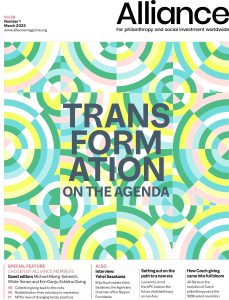Transforming philanthropy means transforming the institutions that practice it. What does this mean for their attitudes and their day-to-day work?
Philanthropy needs to change – this seems to be the common denominator in current debates and in this special feature of Alliance magazine. But what does it really mean for large or small philanthropic organisations to embrace a culture of trust, participation and/or inclusion? This organisational shift is a leadership and management task and presents dilemmas since it raises questions around power and culture within the organisation. Based on our – selective – experiences as managers and advisors in the field and a series of qualitative interviews over the course of the second half of 2022 we try to answer some of these questions.
Let’s go straight to the point, transformation is possible and it’s done by a few, but let’s not minimise the fact that it’s a matter of making a fundamental change in mindset and in the way of conceiving the symbolic, political and social role of philanthropy.
Beyond the important strategic questions of what we are trying to accomplish and why, the questions raised by this change are: who do we serve, to whom are we indebted, to whom do we belong? It’s also about the belief that reciprocity, trust and power-sharing will lead to better results.
To be relevant and useful, after learning and listening carefully to the different components of their ecosystem, there are foundations working to transform themselves from the inside out. They want to be part of the solution. And, what may appear a dilemma in traditional hierarchical management, it requires that leadership (board and CEO) and management strongly understands its role as guardians of this transformation and embodies on a daily basis the core organisational values and principles.
Purpose-driven before organisation-driven
It may sound unbelievable but the first and most important step is to decentre oneself, to stop making the world turn around one’s objectives and to inscribe the foundation’s action in a vision that goes beyond its own confines to resonate and adjust with contemporary priorities and be part of the larger socio-political fabric. After all, it’s not about philanthropy in itself!
The second practical consequence of this principle is that the focus shifts to maximising the foundation’s contribution and the benefits it offers in service to its purpose, sometimes going beyond the strict mission statement. For example, at Chagnon Foundation in Canada, in addition to the grants aligned with the mission of ‘Preventing poverty by helping to create conditions that will enable all young people living in Québec to develop their full potential,’ the foundation aims to invest 10 per cent of capital assets in social initiatives, such as affordable housing, community-owned infrastructure, sustainable and equitable food systems and employment integration.
Do boards and management really know, understand and relate to the various stakeholders of the ecosystem, especially excluded populations and the non-profits that work for them?
Can foundations really afford not to devote all the resources they have (human, social and financial capital, material) to the service of their purpose and values?
For instance, more and more foundations revisit the role and duration of grants, investing in social finance, searching for serious’ and rigorous RI fund managers and even reviewing internal policies and an optimal contribution (ie procurement). Probably more importantly, aside from resources, the most important contribution is the capacity to be an effective and sustainable voice in promoting the cause.
Some would say that the impact is limited, even marginal. That may be so. But it is authentic and in line with the overall mindset of a philanthropic organisation.
Respect for the ecosystem
Over the years, several philanthropic leaders have invited the sector to see each side of the philanthropic relationship, donor and recipients, as integral to the existence of the other, meaning that the relationship is based on mutual trust, interconnectivity, reciprocity and recognition of diverse type of knowledge and expertise.
Let’s think about it – what would foundations be without community non-profits and movements to support? What would foundations be without their profound commitment to not-for-profits and community to jointly improve people’s lives?
What does it really mean for large or small philanthropic organisations to embrace a culture of trust, participation and/or inclusion?
That may seem obvious, but do Boards and management really know, understand and relate to the various stakeholders of the ecosystem, especially excluded populations and the non-profits that work for them? And beyond these, there is the complex socio-political dynamic in which they exist and the various ways foundations’ actions could affect it, positively or not.
To this end, foundations can engage in different forms of assessments, opening up an organisational space for regular introspection and reflection on their practices. Even more important is to share it with various field actors to get a better sense of needs, opportunities and the rapidly changing social, economic and political context. As an example, in the year before transforming itself, Chagnon Foundation met more than 700 representatives of organisations from community, philanthropic, social, early childhood, school, public health, government, municipal, academic, unions and business.
Power sharing
Power is a crucial arena for reflection and action. Recognition of the expertise and knowledge of the various stakeholders and bringing them together in alliance must be reflected in the decision-making spaces and processes.
The voices of stakeholders and community involved in, and affected by, the work the foundation does can be enabled by its internal structure. The most obvious way is to include a significant number of people from civil society in different bodies that make up a foundation; on the board itself to influence policy and direction, but also in other spaces like advisory or consultative bodies who can reflect regularly their assessment of the context and the priorities of communities and through allocation or investment committees where the key financial decisions are taken.
A mindset for equity
With a deep awareness and understanding of existing systemic iniquities, the first prerequisite of board and management is to promote and ensure equity in all areas of work and decision-making within a grantmaking organisation.
Internally, the organisational culture should promote and actualise respect for all types of knowledge and collaboration, should avoid bias and favouritism and take decisions based on facts, treat everyone with fairness, maximise transparency of policies, processes and partnerships.
To give one example, the issue of compensation is often a good test of an organisation’s values, particularly those whose missions are to fight inequities. Some organisations will minimise the gap between the highest and lowest salaries. For others, the compensation structure will be administered in a way that recognises and addresses all forms of equity.
Another way is through recruitment processes, by being transparent in communications, adopting fair selection processes and welcoming diversity as a strength.
Externally, from granting, to investment and communication, foundations can put all their weight behind supporting alternatives, such as non-profit grassroots groups from excluded communities and can identify key policies and conditions that could alleviate systemic and historic forms of discrimination.
It is easy to understand that the application of these principles will have a daily impact on:
- the relationships maintained between board, CEO and staff, based on good cooperation, honesty about successes and failures and a common understanding of opportunities, risks and limits,
- the time and effort invested in a revision of roles and responsibilities of the board of directors and management, and in development of new skills,
- In our experience, to apply these organisational behaviours aligned with values, there is one fundamental condition: a leadership which believes in, and is fully committed to, the vision and the project; determined and at the same time listening and flexible; and which not only promotes, but also embodies the values and principles consistent with the organisation’s approach.
There is much more to say, but the short version of the story is that it’s worth it. Of course, there are many challenges – making sure the reasons for change are understood in time, finding the right balance between transforming and operating, managing strategic tensions, supporting management team and staff, etc – but management will learn and adapt (maybe a fifth principle!) and not much can replace the satisfaction of having concrete practices and actions illustrating the scope of the contribution to change, clarity, meaning and coherence internally and which can also give credibility and differentiate the organisation with external stakeholders.
Jean-Marc Chouinard is Senior strategic management advisor, former CEO of Lucie et André Chagnon Foundation.
Email: chouinardjm@pm.me
Michael Alberg-Seberich is Managing director of Wider Sense.
Email: alberg-seberich@widersense.org
Upcoming issue: Transformation on the agenda
 Transformation is not just change. It implies a more thoroughgoing shake-up of what we do and how we do it. This will mean reconsidering not only how we relate to the rest of society but how we see and behave. How can foundations reconcile the need for humility with a larger purpose? What example should it be setting for others? And what can a new generation bring to the field?
Transformation is not just change. It implies a more thoroughgoing shake-up of what we do and how we do it. This will mean reconsidering not only how we relate to the rest of society but how we see and behave. How can foundations reconcile the need for humility with a larger purpose? What example should it be setting for others? And what can a new generation bring to the field?





Comments (0)
Jun88 ✅✅ Link vào Jun88 tv, tải app Jun88 mobile mới nhất. Đăng ký nhà cái Jun88 chơi casino online hấp dẫn, kèo nhà cái uy tín, tỷ lệ cược ăn cao. Website: https://www.jun88mk.com/
The foundations operate within a complex socio-political environment, and their actions have the potential to impact it in both positive and negative ways.
Leading this transformation requires committed leadership that embodies the organization's values, embraces change, and fosters a culture of transparency, learning, and adaptation.